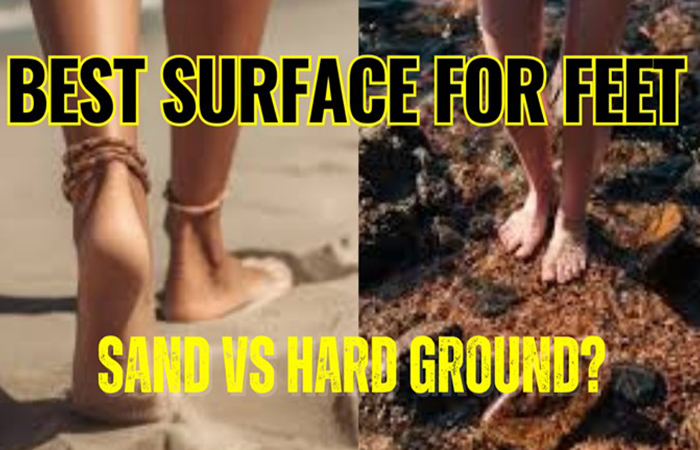Walking on Sand vs Hard Ground—What Your Feet Really Need

When it comes to foot health, the type of surface you walk on matters more than you think. In Tamil Nadu, where lifestyles range from beach walks in Chennai to long commutes on Madurai’s concrete pavements, people often wonder—“Is walking on sand better than walking on hard ground?”
At Upstrol Technologies, Madurai, where we design custom orthopaedic sandals and slippers with arch support, we frequently meet patients asking this very question. The truth lies in understanding how different surfaces affect your feet, especially if you have podiatric conditions like heel pain, flat feet, or diabetic foot disorders.
Walking on Sand: The Natural Cushion
Sand is soft, uneven, and constantly shifting under your feet. This makes walking on sand a natural exercise for your foot muscles.
Benefits of Walking on Sand
- Low Impact on Joints – Sand absorbs shocks, reducing pressure on knees and ankles.
- Strengthens Foot Muscles – The instability of sand makes your intrinsic foot muscles and calves work harder.
- Improves Balance – Especially for flat-footed people, sand helps train balance and stability.
- Burns More Calories – Studies suggest walking on sand burns up to 2x more calories compared to walking on hard ground.
- Relaxing & Therapeutic – A beach walk in Rameswaram or Kanyakumari is not just exercise—it reduces stress and boosts mood.
[Insert Image: Person walking barefoot on beach sand with footprints]
Risks of Walking on Sand
- Overuse Injuries: Too much barefoot walking may cause plantar fasciitis or Achilles tendon strain.
- Risk for Diabetic Patients: Hot sand can burn feet without them realizing, due to reduced sensation.
- Arch Stress: Without proper footwear, flat-footed people may feel discomfort after prolonged walks.
Walking on Hard Ground: The Urban Reality
For most people in Tamil Nadu’s cities—Madurai, Coimbatore, Chennai—walking on hard ground like cement, tiles, or tar roads is a daily routine.
Benefits of Walking on Hard Ground
- Accessibility – Most daily commutes, office walks, and fitness walks happen here.
- Predictable Surface – Unlike sand, hard ground is stable and safe for the elderly.
- Good for Speed Walking & Running – With the right orthopaedic footwear, walking on hard surfaces can be safe and effective.
[Insert Image: Man walking on tiled pavement in sports shoes]
Risks of Walking on Hard Ground
- High Impact Stress – Increases the risk of heel pain, shin splints, and knee arthritis.
- Flat Feet Worsening – Hard ground doesn’t support the natural curve of the foot.
- Increased Diabetic Complications – Rigid surfaces increase chances of foot ulcers if footwear isn’t cushioned.
Current Trends & Health Facts in Tamil Nadu
- According to a 2023 survey by the Indian Podiatry Association, 1 in 3 adults in Tamil Nadu report some form of foot pain due to prolonged walking on hard surfaces.
- Diabetes prevalence in Tamil Nadu is nearly 16%, one of the highest in India. This makes protective footwear with cushioned soles (EVA, PU, or Silicone) crucial.
- Orthopaedic footwear demand in South India is growing at 12–15% annually, with more working professionals choosing preventive footwear to avoid long-term issues.
[Insert Image: Infographic showing comparison between Sand walking vs Hard ground walking]
What Your Feet Really Need? (Expert Opinion)
Whether you walk on sand or hard ground, the key lies in choosing the right footwear. Barefoot walking on sand may be great for occasional exercise, but daily walking on hard ground demands extra cushioning and arch support.
For Different Segments:
- Therapeutic Footwear (TFW) – For diabetic patients & those with foot ulcers → Silicone/EVA cushioned sole with rocker bottom.
- Preventive Footwear (PFW) – For IT professionals & long-standing workers → PU soles with arch support.
- Fitness Freaks (FFs) – For runners & walkers → Shock-absorbing EVA/PU soles with heel cushioning.
- Retailers – Offering both budget and premium models ensures every customer can access foot-friendly choices.
Key Takeaway
- Walking on Sand → Great for muscle strength, balance, and calorie burn, but risky for diabetics & prolonged use.
- Walking on Hard Ground → Practical for daily life, but only safe with proper orthopaedic sandals or shoes.
At Upstrol Technologies, Madurai, we believe your feet deserve personalized care. With custom orthopaedic slippers and sandals, we make sure whether you walk on the beach sand or the city pavement—your feet stay pain-free and protected.
[Insert Image: Customised Upstrol Sandals with Arch Support]
Final Words
Your feet carry you through 10,000+ steps daily. Instead of asking whether sand or hard ground is better, ask yourself—“Am I wearing the right footwear for my lifestyle?”
If you have foot pain, diabetes, or flat feet, don’t ignore it. Invest in customised orthopaedic footwear today—because healthy feet mean a healthier life.

